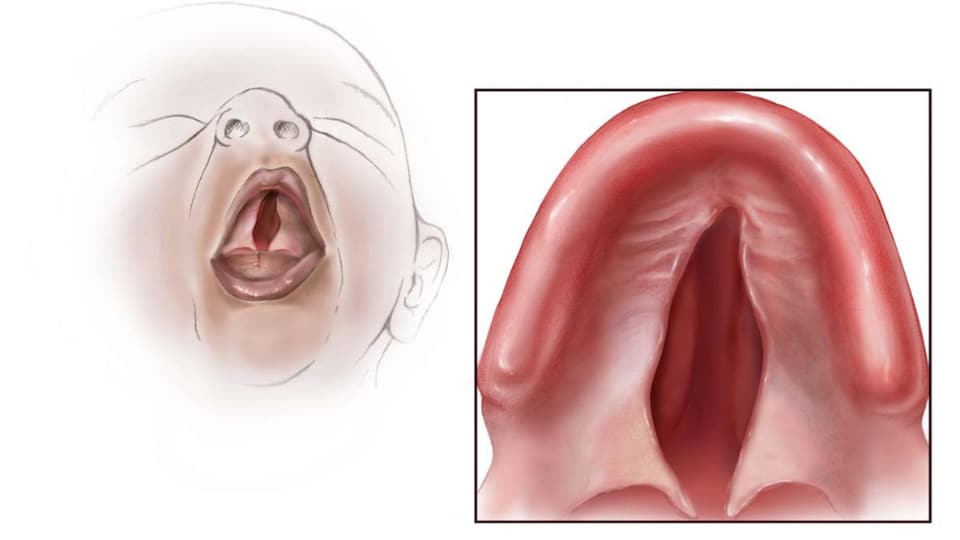Key points
- Cleft lip and cleft palate are birth defects that occur when a baby's lip or mouth don't form properly.
- In the United States, about 1 in 1,050 babies is born with cleft lip with or without cleft palate.
- In the United States, about 1 in 1,600 babies is born with cleft palate alone.
What it is
Cleft lip
The lip forms between the fourth and seventh weeks of pregnancy. During development, body tissue and special cells from each side of the head grow toward the center of the face. They join together to form facial features like the lips and mouth.
A cleft lip happens if the tissue making up the upper lip doesn't join completely before birth, leaving an opening. The opening can be small, or it can go through the lip into the nose.
A cleft lip can be on one or both sides of the lip or in the middle of the lip. Children with a cleft lip also can have a cleft palate.

Cleft palate
The roof of the mouth (palate) is formed between the sixth and ninth weeks of pregnancy. A cleft palate happens if the tissue that makes up the palate doesn't join together completely. For some babies, both the front and back parts of the palate are open. For other babies, only part of the palate is open.

Together, these birth defects are called "orofacial clefts". If the orofacial clefts are not surgically repaired, children with these conditions have problems with feeding and speaking clearly. They may also more often have ear infections and hearing problems, or problems with their teeth.
Risk factors
The causes of orofacial clefts among most infants are unknown. Cleft lip and cleft palate are thought to be caused by a combination of genes and other factors.
CDC research has found some factors that increase the risk of having a baby with an orofacial cleft:
Diagnosis
Orofacial clefts, especially cleft lip, can be diagnosed during pregnancy by a routine ultrasound. They can also be diagnosed after the baby is born. Certain types of cleft palate (for example, submucous cleft palate and bifid uvula) might not be diagnosed until later in life.
Treatment
Services and treatment for children with orofacial clefts can vary depending on:
- The severity of the cleft
- The child's age and needs
- The presence of associated syndromes or other birth defects
Surgery to repair a cleft lip usually occurs in the first few months of life. It is recommended within the first 12 months of life. Surgery to repair a cleft palate is recommended within the first 18 months of life, or earlier if possible.6 Many children will need additional surgical procedures as they get older.
Surgical repair can help restore function to the lips and mouth. It may help improve breathing, hearing, and speech and language development. Children born with orofacial clefts may also need special dental or orthodontic care or speech therapy.67
With treatment, most children with orofacial clefts do well and lead a healthy life. Some children may have issues with self-esteem if they are concerned with visible differences between themselves and other children.
Resources
The views of these organizations are their own and do not reflect the official position of CDC.
Children's Craniofacial Association (CCA): CCA addresses the medical, financial, psychosocial, emotional, and educational concerns relating to craniofacial conditions.
The National Craniofacial Association (FACES): FACES is dedicated to assisting children and adults who have craniofacial disorders resulting from disease, accident, or birth.
American Cleft Palate Craniofacial Association (ACPA): Care for children with craniofacial conditions is often best managed when a team of specialists works with the family to develop a treatment plan. ACPA is dedicated to team care and to optimizing outcomes for patients.
- Little J, Cardy A, Munger RG. Tobacco smoking and oral clefts: a meta-analysis. Bull World Health Organ. 2004;82:213-18.
- Honein MA, Rasmussen SA, Reefhuis J, Romitti P, Lammer EJ, Sun L, Correa A. Maternal smoking, environmental tobacco smoke, and the risk of oral clefts. Epidemiology 2007;18:226–33.
- Correa A, Gilboa SM, Besser LM, Botto LD, Moore CA, Hobbs CA, Cleves MA, Riehle-Colarusso TJ, Waller DK, Reece EA. Diabetes mellitus and birth defects. American Journal of Obstetrics and Gynecology 2008;199:237.e1-9.
- Margulis AV, Mitchell AA, Gilboa SM, Werler MM, Glynn RJ, Hernandez-Diaz S, National Birth Defects Prevention Study. Use of topiramate in pregnancy and risk of oral clefts. American Journal of Obstetrics and Gynecology 2012;207:405.e1-e7.
- Werler MM, Ahrens KA, Bosco JL, Michell AA, Anderka MT, Gilboa SM, Holmes LB, National Birth Defects Prevention Study. Use of antiepileptic medications in pregnancy in relation to risks of birth defects. Annals of Epidemiology 2011;21:842-50.
- American Cleft Palate-Craniofacial Association. Parameters for evaluation and treatment of patients with cleft lip/palate or other craniofacial anomalies. Revised edition, Nov 2009. Chapel Hill, NC. P. 1-34. https://acpa-cpf.org/wp-content/uploads/2017/06/Parameters_Rev_2009_9_.pdf
- Yazdy MM, Autry AR, Honein MA, Frias JL. Use of special education services by children with orofacial clefts. Birth Defects Research (Part A): Clinical and Molecular Teratology 2008;82:147-54.
- Stallings, E. B., Isenburg, J. L., Rutkowski, R. E., Kirby, R. S., Nembhard, W.N., Sandidge, T., Villavicencio, S., Nguyen, H. H., McMahon, D. M., Nestoridi, E., Pabst, L. J., for the National Birth Defects Prevention Network. National population-based estimates for major birth defects, 2016–2020. Birth Defects Research. 2024 Jan;116(1), e2301.
